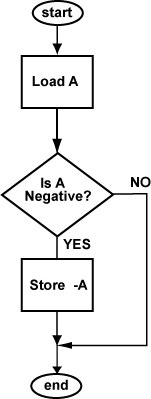No.

You can build a real rats-nest of code with assembly language. Avoid this by implementing the structures of a high level language. Draw a flowchart of the program or rough it out in C or Java before coding. Put comments in the assembly source program before you add code to show how the code and the flowchart correspond.
The flowchart at right shows a program that calculates the absolute value of the integer at symbolic address "A". The program follows that logic.
Assume that "A" starts at
address 0x10000000.
The lui instruction
points the base register $10 at that address.
## absVal.asm
##
## Calculate the absolute value of A
.text
.globl main
main:
# Get A
lui $10,0x1000 # Initialize the
# base register
lw $8,($10) # Load A
$0,$0,0 # load delay slot
# Is A Negative?
# Store -A
done:
.data
A: .word -1
Fill in the blanks.